Design and construction
Childers, a first-class torpedo boat, was constructed for the colony of Victoria by John I. Thornycroft & Company on the River Thames at Chiswick, England, as Yard No. 172. Her length was 113 ft 0 in (34.44 m) overall and 111 ft 8 in (34.04 m) waterline, with beam 12 ft 6 in (3.81 m) and 5 ft 6 in (1.68 m) draught; her displacement was 60.5 tons. [1] Childers was powered by a two-cylinder compound steam engine of 679 bhp (506 kW) giving a service speed of 19–20 knots (35–37 km/h; 22–23 mph). She had a complement of 18 and was armed with two fixed bow tubes for 15-inch Whitehead torpedos and two 1-pounder Hotchkiss machine guns. [1] [2]
The vessel was ordered in August 1882, [3] laid down in 1883, and launched on 18 August that year by the wife of the Chancellor of the Exchequer and former First Sea Lord, Hugh Childers, after whom the vessel was named; he had spent the first seven years of his working life in the Victoria colonial administration in the 1850s. [1] [4] Childers was budgeted at £10,500, with a builder's cost outturn of £11,027. [1] For the delivery voyage to Melbourne the boat was fitted with three masts and 1,000 square feet of canvas to supplement her limited coal capacity, [4] and her trials were made on 16 November. [1]
Operational history
HMVS Childers sailed from Portsmouth on 3 February 1884. [5] Shortly before reaching the Mediterranean, she ran short of coal, and was towed into the Gibraltar Straits by the British steamer Pathan. [6] On 13 February, while Childers was en route to her scheduled rendezvous in Malta with the new gunboats HMVS Victoria and HMVS Albert, the Government of Victoria offered the assistanc of the three vessels in support of the British Sudan Campaign. [7] The British government noted however that, while appreciating the loyal offer, it did not see an appropriate service for them. [8] Nevertheless, Childers pressed on ahead, and on 19 March reached Suakin, Sudan, as did the two gunboats, meeting for the first time, and confirming that assistance was not required locally. [9] Thereafter the flotilla steamed more generally in concert, though the tow from Aden to Batavia via Colombo by Victoria was uncomfortable, and they reached Thursday Island on 18 May. Continuing via east coast ports, on 13 June they arrived at Port Jackson, Sydney, where they were painted white afresh and spruced up before being received in their home waters off Williamstown on 25 June [9] [10]
Childers joined the Commonwealth Naval Forces following federation in 1901, and the Royal Australian Navy when it was formed in 1911. During World War I she served in Victorian waters and as a tender to HMAS Cerberus.

HMVS Cerberus is a breastwork monitor that served in the Victoria Naval Forces, the Commonwealth Naval Forces (CNF), and the Royal Australian Navy (RAN) between 1871 and 1924.

Admiral of the Fleet Sir Arthur Knyvet Wilson, 3rd Baronet, was a Royal Navy officer. He served in the Anglo-Egyptian War and then the Mahdist War being awarded the Victoria Cross during the Battle of El Teb in February 1884. He went on to command a battleship, the torpedo school HMS Vernon and then another battleship before taking charge of the Experimental Torpedo Squadron. He later commanded the Channel Fleet. He briefly served as First Sea Lord but in that role he "was abrasive, inarticulate, and autocratic" and was really only selected as Admiral Fisher's successor because he was a supporter of Fisher's reforms. Wilson survived for even less time than was intended by the stop-gap nature of his appointment because of his opposition to the establishment of a Naval Staff. Appointed an advisor at the start of World War I, he advocated offensive schemes in the North Sea including the capture of Heligoland and was an early proponent of the development and use of submarines in the Royal Navy.

HMS Hussar was a Dryad-class torpedo gunboat of the Royal Navy. She was launched in 1894 and served in the Mediterranean between 1896 and 1905 before being used for fishery protection. During the Dardanelles campaign of 1915 her commanding officer and two of her ship's company won the Victoria Cross. She was broken up in 1921.
Royal Australian Naval Volunteer Reserve (RANVR) was a reserve force of the Royal Australian Navy.
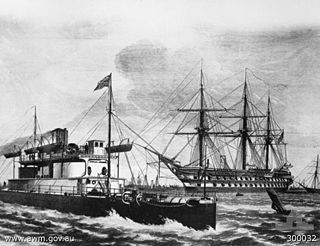
Before Federation in 1901 five of the six separate colonies maintained their own naval forces for defence. The colonial navies were supported by the ships of the Royal Navy's Australian Station which was established in 1859. The separate colonies maintained control over their respective navies until 1 March 1901, when the Commonwealth Naval Forces was created.

HMQS Mosquito was a torpedo boat operated by the Queensland Maritime Defence Force and Commonwealth Naval Forces. She entered service in 1885 and after Federation was transferred to the Commonwealth Naval Forces, serving as a training vessel until she was paid off in 1910.

Yangwei was a cruiser built for the Imperial Chinese Navy. She was built by Charles Mitchell & Company in Newcastle Upon Tyne, England, from a design by Sir George Wightwick Rendel which had already been used on the Chilean Navy vessel Arturo Prat. Two ships were ordered by the Chinese, the Yangwei and the Chaoyong. Both would serve together throughout their careers, assigned to the Beiyang Fleet and based in Taku during the summer, and Chemulpo, Korea, in the winter.

RMS Quetta was an iron-hulled steamship that was built in Scotland in 1881 and wrecked with great loss of life in the Torres Strait in 1890. She was operated by British India Associated Steamers (BIAS), which was controlled by the British India Steam Navigation Company (BISN). She was wrecked on a previously unknown rock, which has been called Quetta Rock ever since. The Underwater Cultural Heritage Act 2018 protects the wreck.
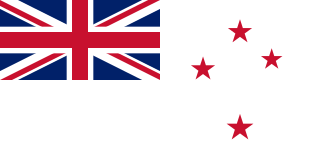
A range of naval vessels were used in New Zealand from its early settlement years to the formation of the New Zealand Naval Forces in 1913. In the mid-19th century, these vessels included frigates, sloops, schooners, and steam-driven paddlewheel boats. In 1846, five years after New Zealand was first proclaimed a colony, it bought its first gunboat. In the 1840s and 1850s, steam boats were used to survey the ports and the coastline. In the 1860s, New Zealand established the Waikato flotilla, its first de facto navy.

HMVS Victoria was a 580-ton combined steam/sail sloop-of-war built in England in the 1850s for the colony of Victoria, Australia.

The BL 8 inch guns Mark I to Mark VII were the first generations of British rifled breechloaders of medium-heavy calibre. They were initially designed for gunpowder propellants and were of both 25.5 and 30 calibres lengths.
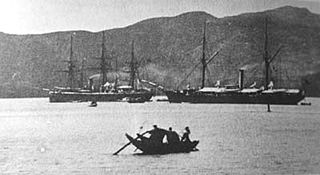
Yangwu was a wooden corvette built for the Imperial Chinese Navy. She was built in 1872 at the Foochow Arsenal, and was the largest ship built there from the shipbuilding programme of 1868–75. During her early career, she was used as a training ship and under the command of English captains. She later saw action in the Battle of Fuzhou in 1884, the opening action of the Sino-French War, where she acted as the flagship of the Fujian Fleet. Shortly after the start of the battle, she was damaged by a spar torpedo, causing a large explosion and the loss of the majority of her crew; she was sunk shortly afterwards by enemy fire.
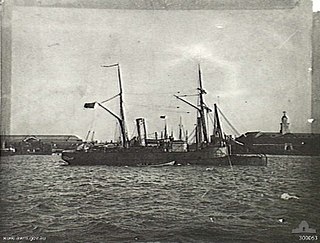
HMVS Victoria was a gunboat that served with the Victorian Naval Forces and Western Australia before being sold into private use.
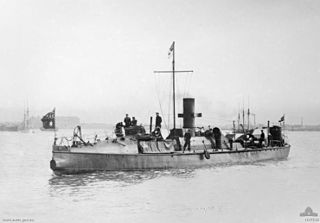
HMVS Countess of Hopetoun was a 1st Class Torpedo Boat of the Victorian Naval Forces, Commonwealth Naval Forces and the Royal Australian Navy. She was named after Hersey, Countess of Hopetoun and later Marchioness of Linlithgow, the wife of the 7th Earl of Hopetoun, the then Governor of Victoria and later the first Governor-General of Australia.
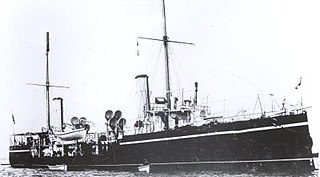
The sixth HMS Hazard was a Dryad-class torpedo gunboat of the Royal Navy. She was launched in 1894 and was converted into the world's first submarine depot ship in 1901. She collided with the submarine A3 on 2 February 1912, killing 14 men, and was herself sunk in collision with SS Western Australia on 28 January 1918.

The BL 6-inch 80-pounder gun Mk I was the first generation of British 6-inch breechloading naval gun after it switched from muzzle-loaders in 1880. They were originally designed to use the old gunpowder propellants.
HMVS Gordon was a torpedo boat operated by the Victorian Naval Forces, the Commonwealth Naval Forces, and the Royal Australian Navy. She was launched in 1884 and lost in an accident in 1914.
HMVS Lonsdale was a second-class torpedo boat constructed for the Victorian Naval Forces and later operated by the Commonwealth Naval Forces and the Royal Australian Navy. She was sunk on mud flats on Swan Island in Port Phillip Bay in 1912 after being stripped of equipment and machinery. Having been commissioned in 1884, and then officially joining the Commonwealth Naval forces in 1901, the boat was the oldest ship in the Royal Navy, and is the oldest Royal Australian Navy ship still in existence.
HMVS Nepean was a Victorian Naval Forces second-class torpedo boat and was later operated by the Commonwealth Naval Forces and the Royal Australian Navy.















